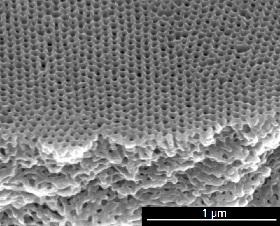Using AI to control energy for indoor agriculture
30 September 2024
Published online 2 November 2010

A simple method to produce high-quality nanoporous membranes developed at the King Abdullah University of Science and Technology (KAUST) promises many diverse advances, ranging from better water purification to faster haemodialysis machines in hospitals.
The new method, published in the journal Macromolecules, produces uniform, highly porous films that are 100–400 nm thick. The researchers merged two methods of film production. This new combination technique can be scaled up to industrial levels, mass producing high-quality membranes that can be used for medical processes and water purification, claim the researchers.
Most available porous membranes used in ultrafiltration are produced using a process called phase inversion, in which a thin film is precipitated in a non-solvent solution. This step freezes the pores in place. "These membranes have a more or less large statistical distribution of pores with different diameters," said Klaus-Viktor Peinemann, a researcher at KAUST's Advanced Membranes and Porous Materials Center and a co-author of the paper.
The irregularly sized pores, however, are not reliable for the precise separation of molecules of similar molecular weights. Over time, the larger pores start to clog, a process called fouling, which reduced flow through the membrane. "This happens because most of the liquid passes through the pores with large diameter," adds Peinemann.
To tackle this limitation, Peinemann and colleague Suzana Nunes turned to the self-assembly property of block copolymers. Block copolymers are composed of at least two sequences of monomers covalently bonded together, each with different properties. While the self-assembling block copolymers can yield wonderful results, the method is too complicated and time-consuming to be viable commercially, explained Peinemann.
The team advance on this technique by combining it with the well-established phase inversion approach. They added metal ions to stabilize the formation of tiny aggregates of molecules, known as micelles, of the block copolymers. The metal ions also influence the direction of the self-assembly of the block copolymers as desired. The solution was then spread into a 100 µm think film and quickly evaporated. "The micelles self-assemble into a highly ordered hexagonal structure," explained Peinemann.
The micelles were then precipitated in a water bath for the phase inversion stage, which freezes the structure in place to offer the highly porous nanomembrane. "We achieved a breakthrough by combining the Block copolymers self-assembly with a fast and simple membrane manufacturing method," added Peinemann.
The researchers are hopeful the new membranes can be used to improve the various medical and pharmaceutical processes that use ultrathin membranes.
Haemodialysis can be quickened by using membranes with a higher flux capacity. The size of the pores must also be precise to ensure reliable filtration of a patient's blood. According to the research paper, the membranes produced by the new method developed at KAUST have a high porosity, coupled with uniformly-sized pores, which give them a water flux at least 1 order of magnitude higher than other commercially available membranes of similar pore size.
The uniform, tiny pores can also be used for water filtration to remove human waste contaminants, such as antibiotics and hormones.
Peinemann, who co-founded GMT Membrantechnik, a company that manufactures membranes, in Germany 15 years ago, is now considering starting another company in Saudi Arabia to manufacture the new membrane. "The up-scaling is simple, because nearly conventional membrane casting machines can be used to produce this new generation of membranes."
The researchers are also seeking a patent for the new technology, as they continue refining the technique to produce membranes with various properties.
doi:10.1038/nmiddleeast.2010.219
Stay connected: